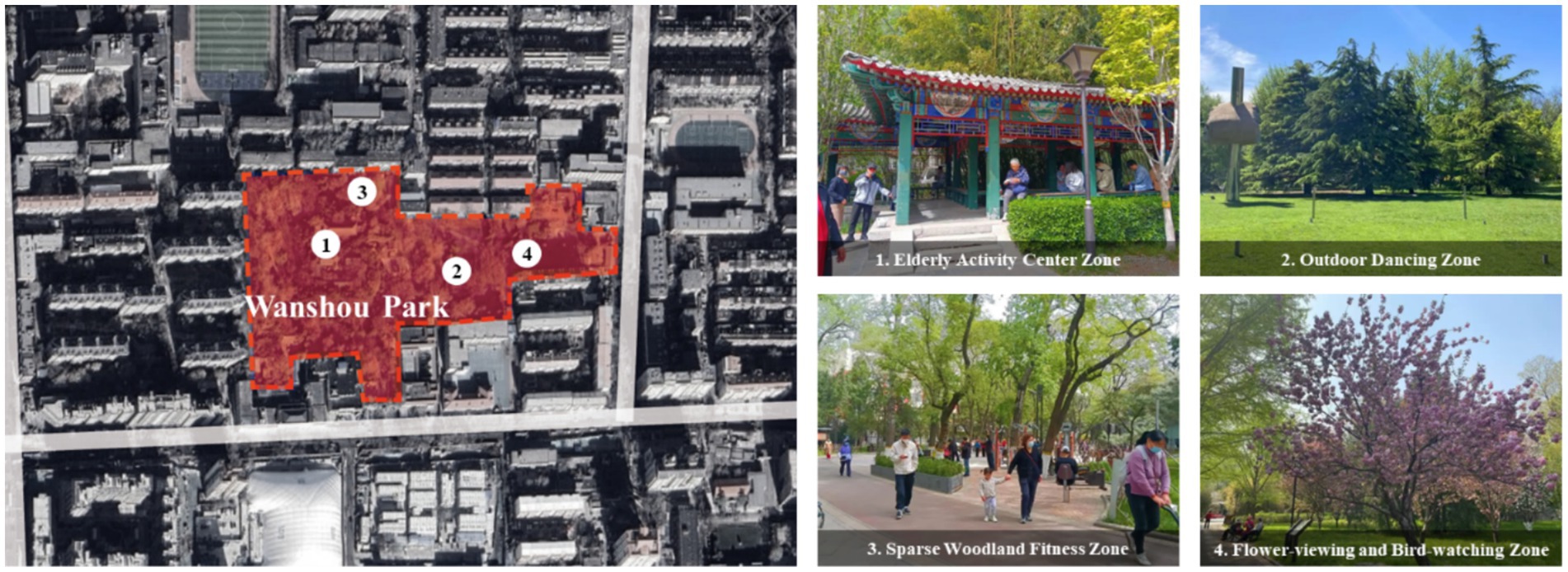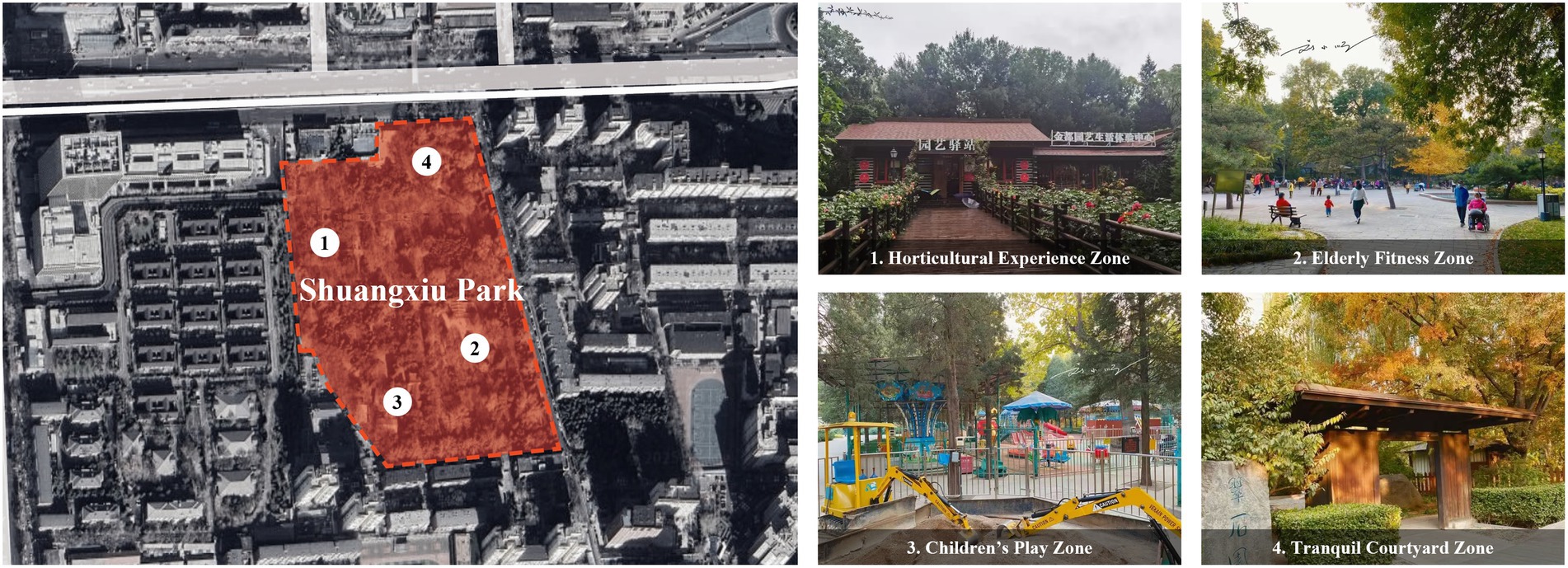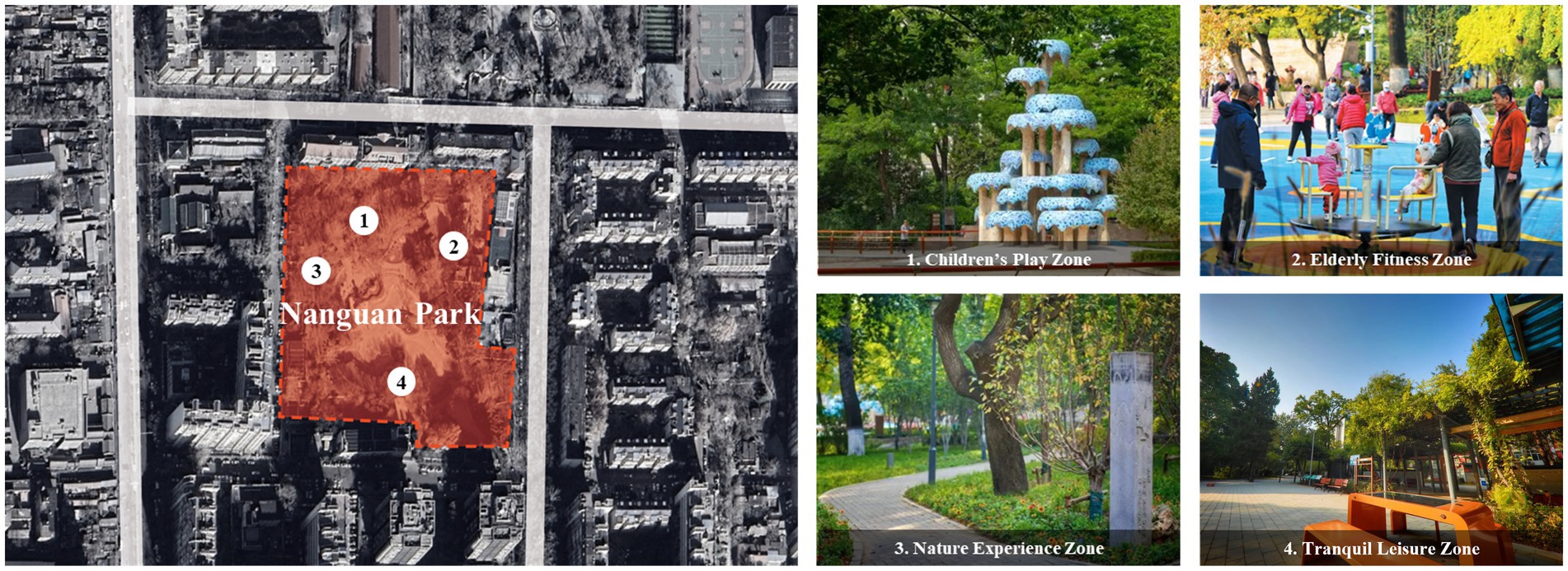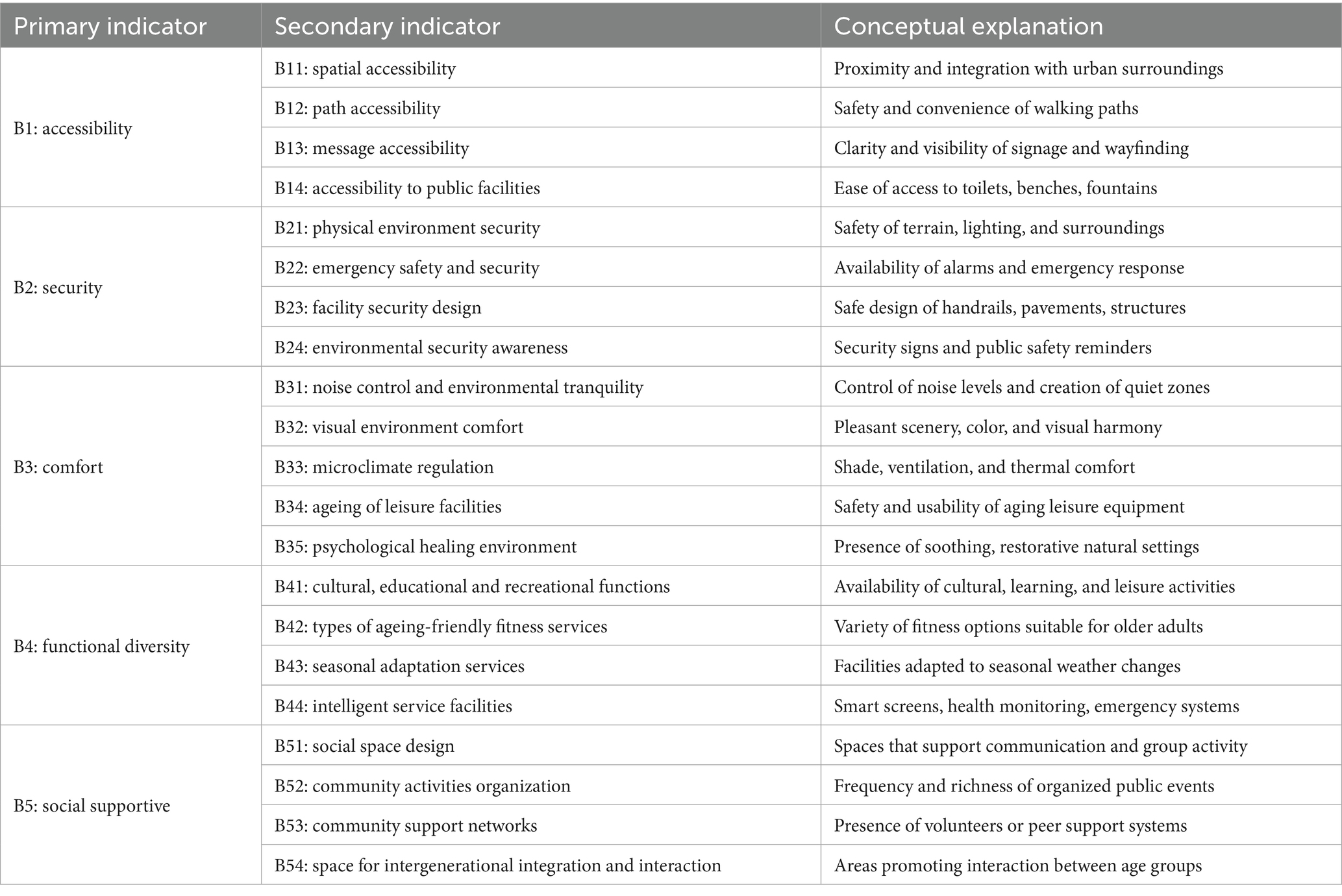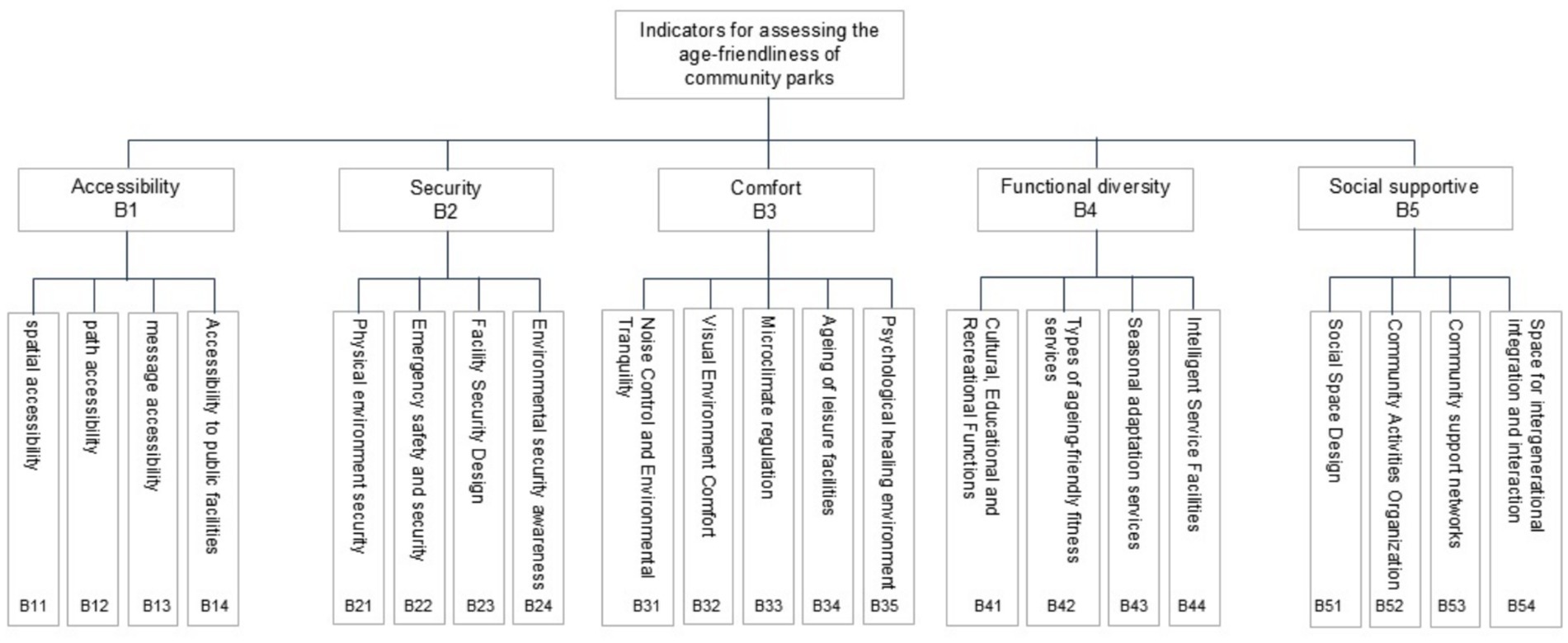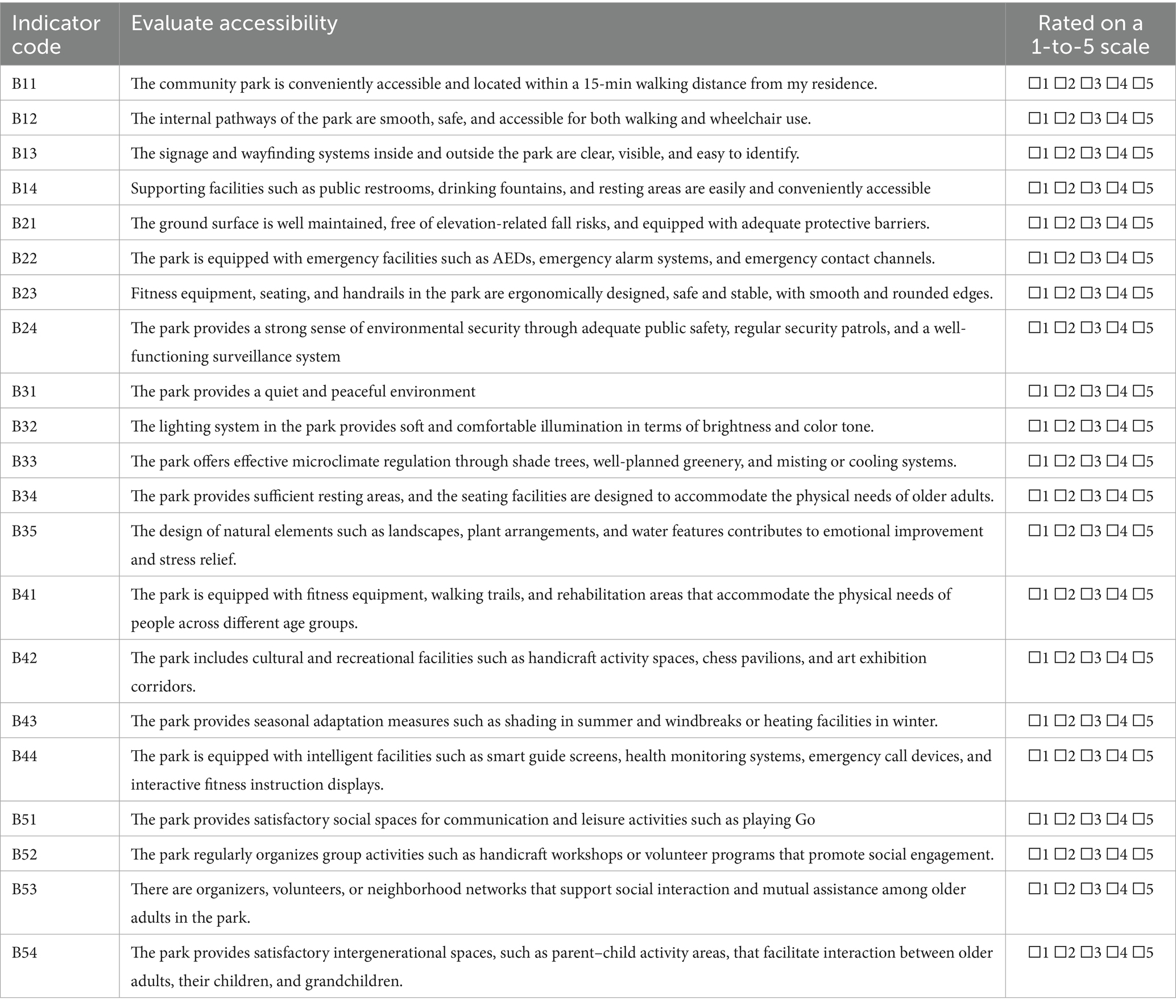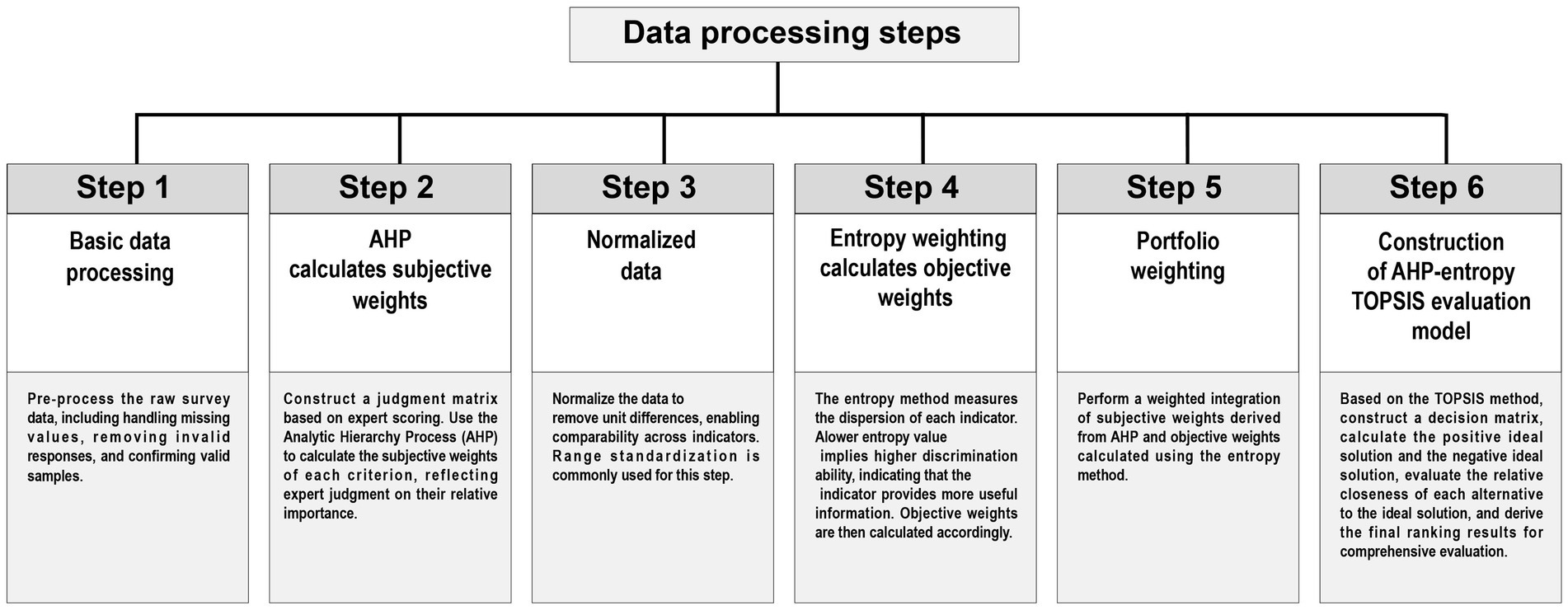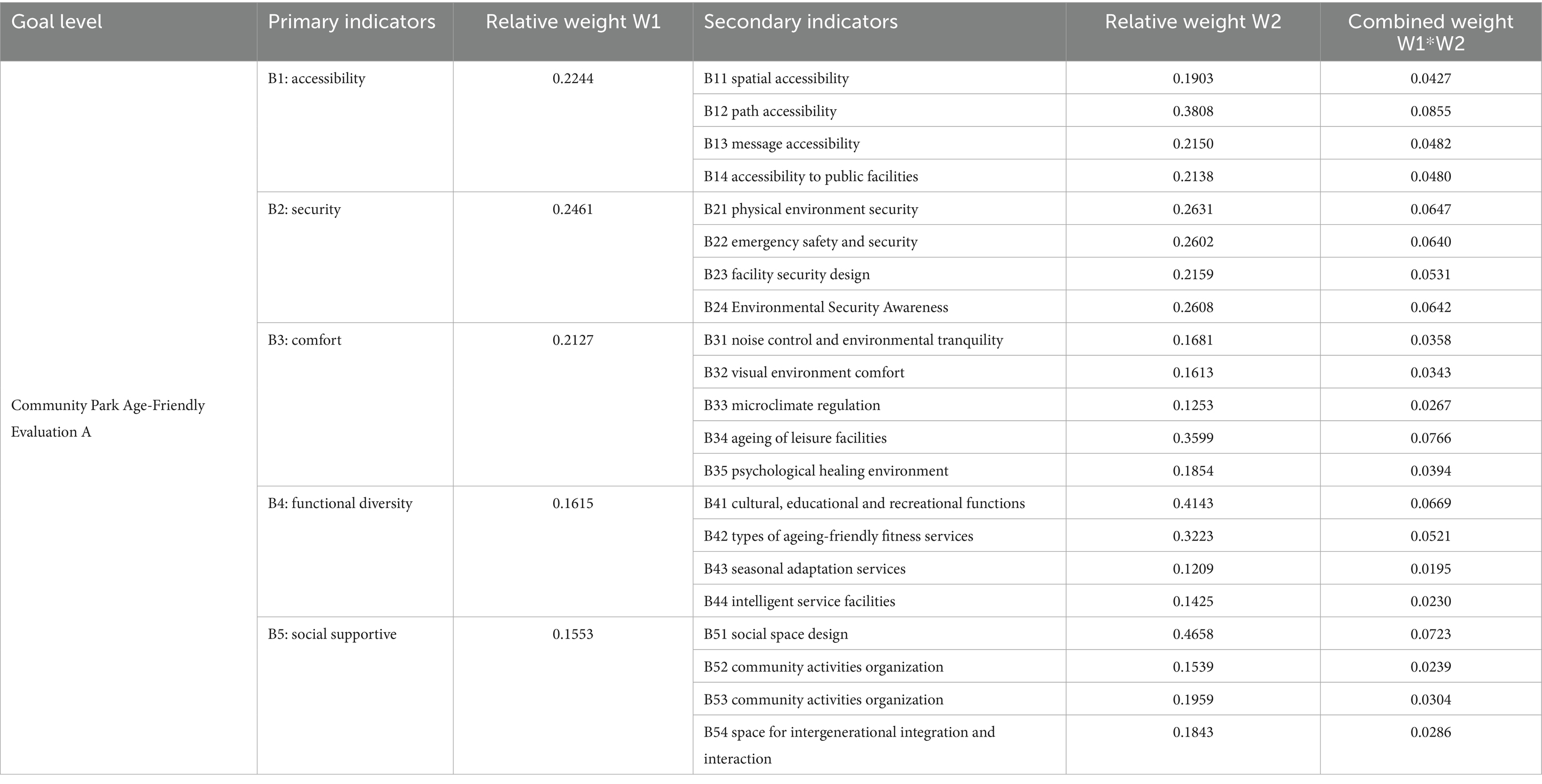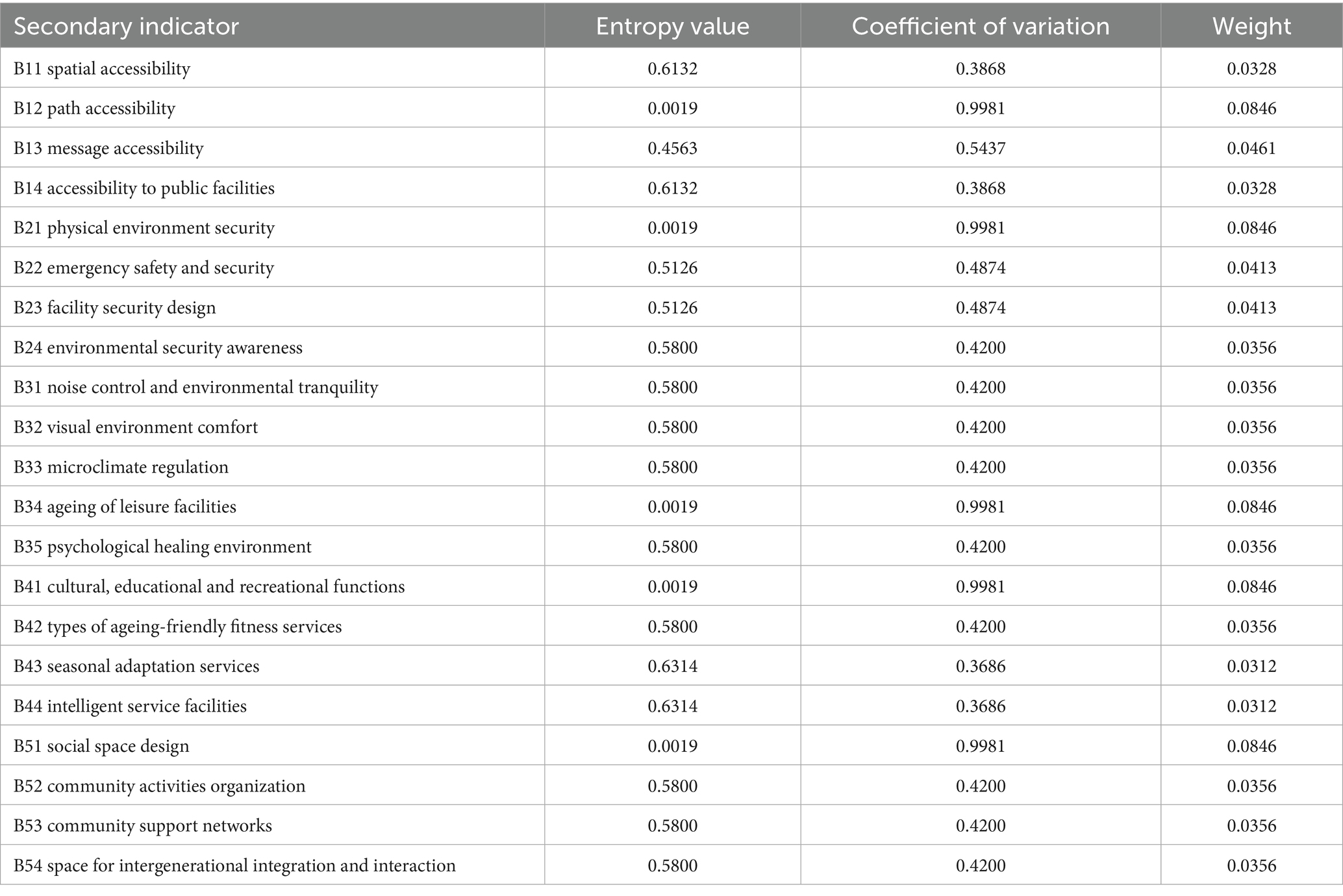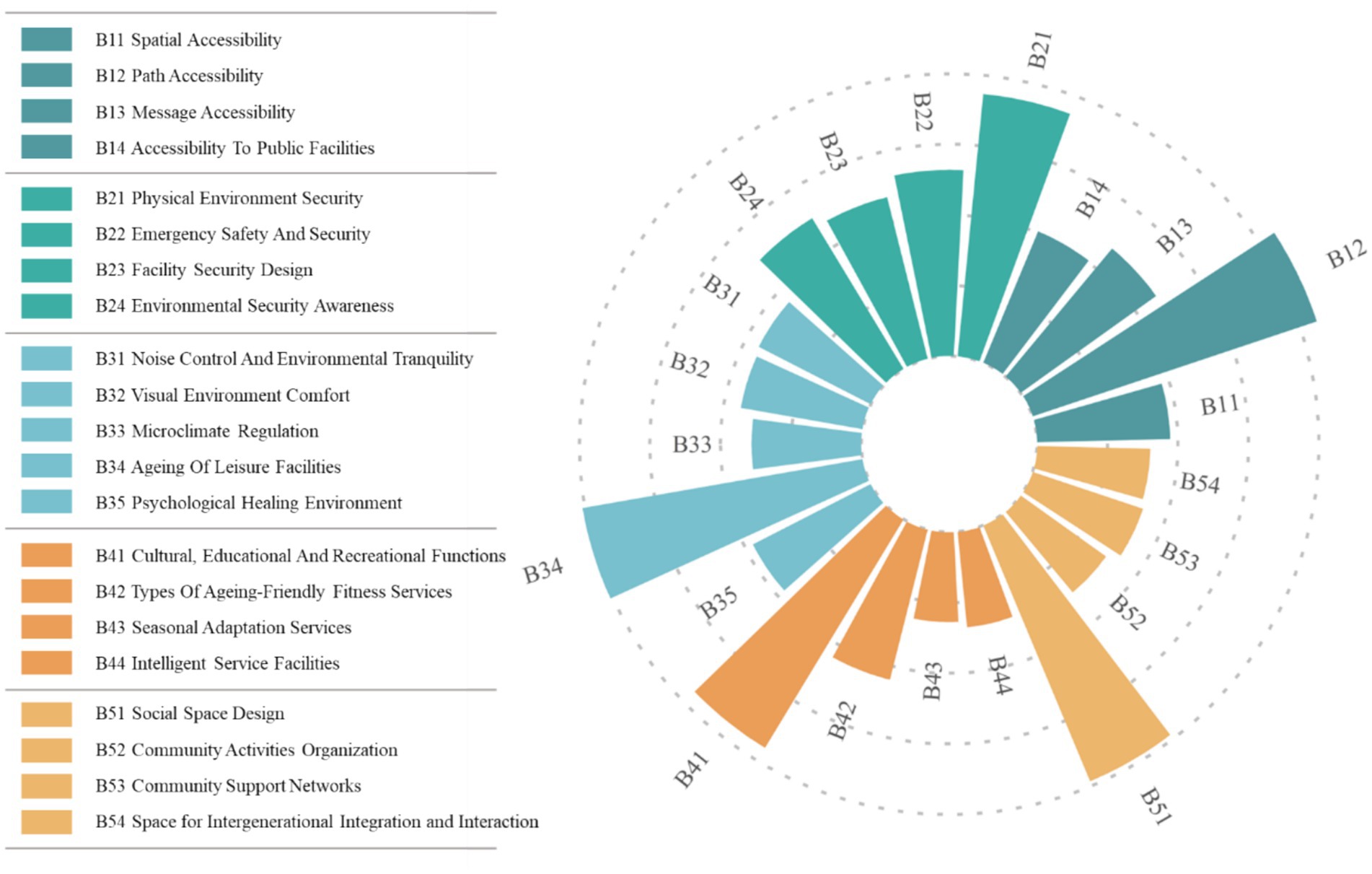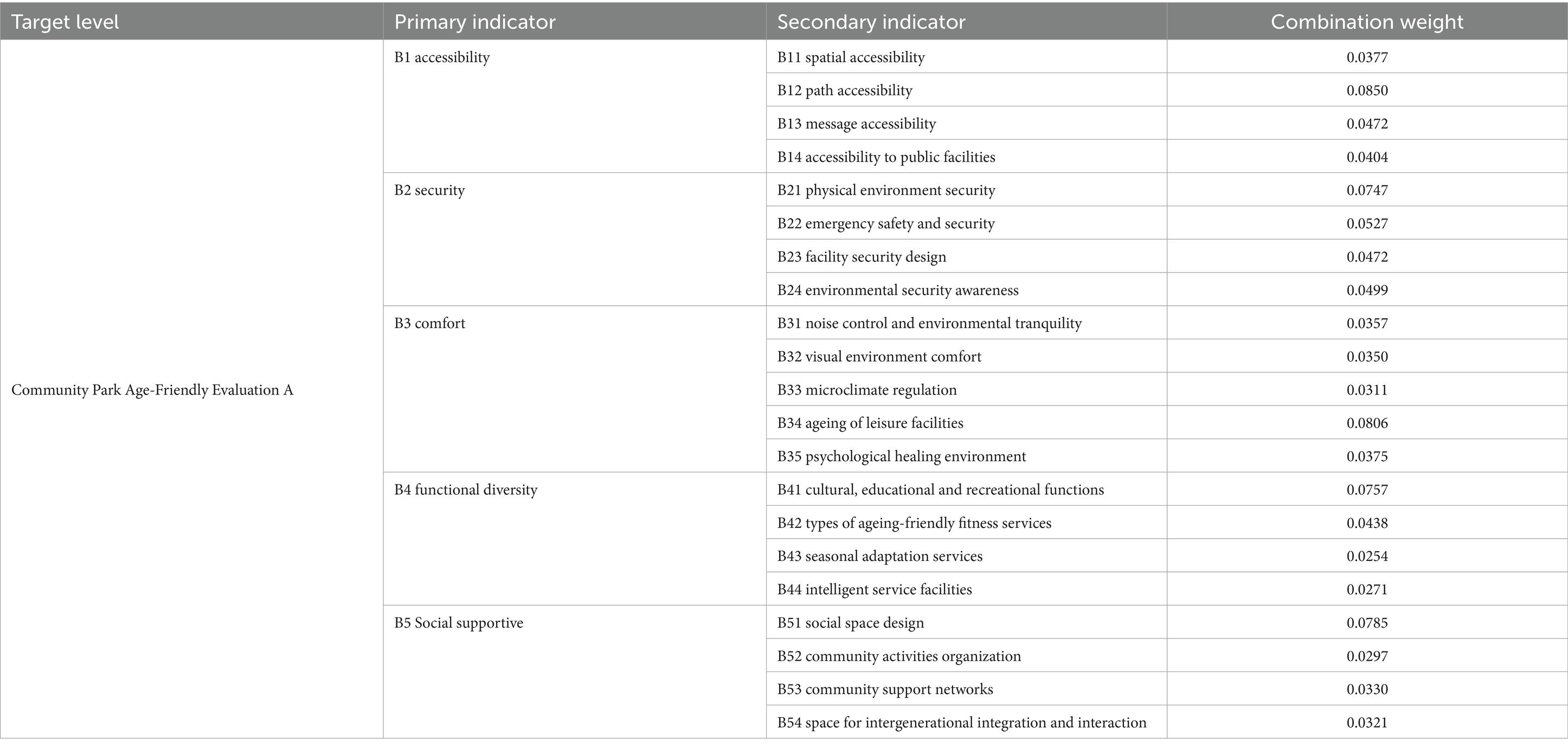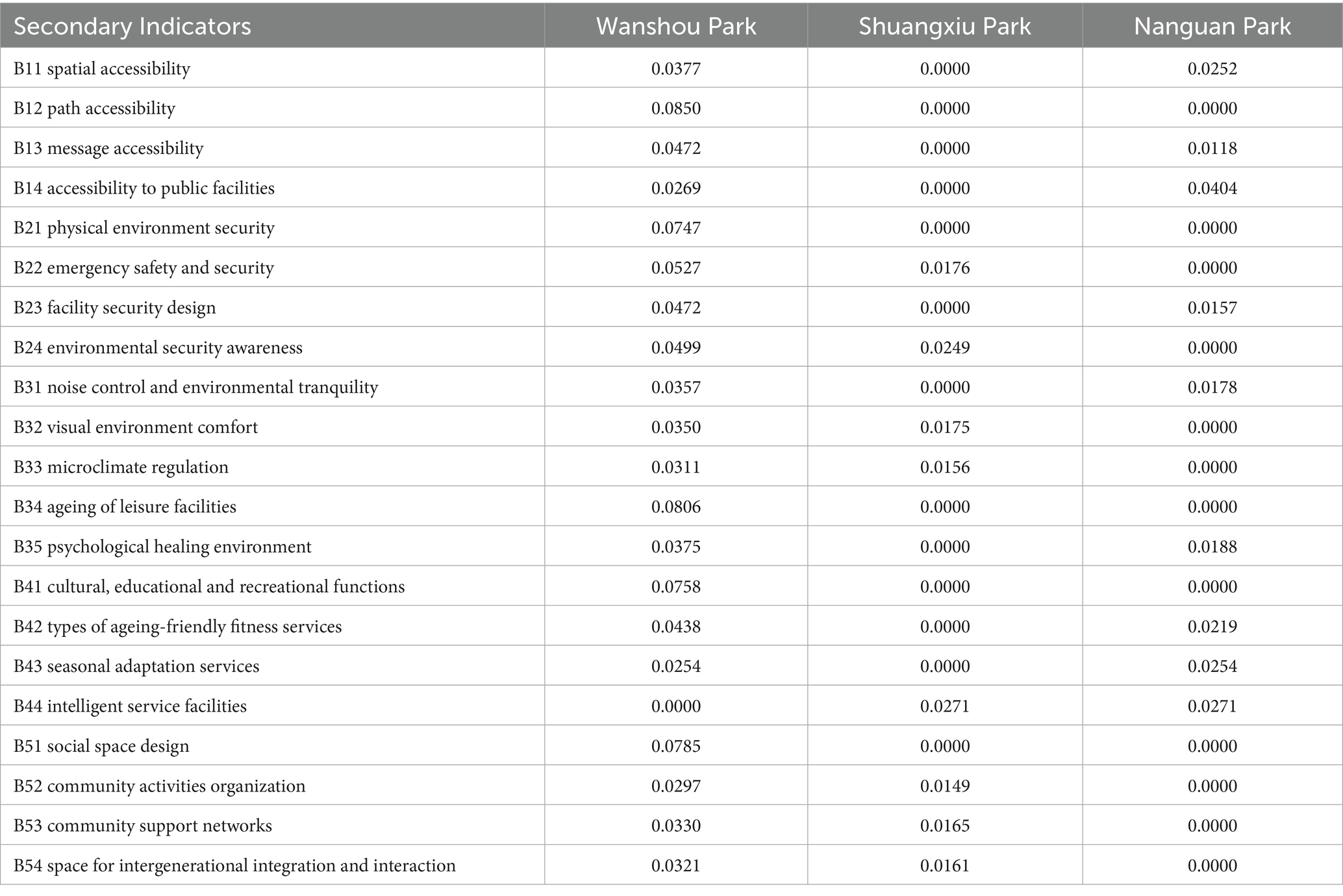- 1Department of Architectural Engineering, Dongshin University, Naju, Republic of Korea
- 2School of Energy and Constructional Engineering, Shandong Huayu University of Technology, Dezhou, Shandong, China
Introduction: With the acceleration of population ageing, community parks have become vital spaces for older adults’ daily activities. The age-friendliness of their spatial environment directly impacts the well-being of the older adult population. Scientifically evaluating the age-friendliness of community parks and proposing optimization strategies is crucial to promoting the physical and mental well-being of the older adults and enhancing the quality of urban public services.
Methods: This study established an evaluation index system for the age-friendliness of community parks through field surveys, literature review, expert screening, and statistical validation. User perception data were collected via questionnaires, and a combination of the Analytic Hierarchy Process (AHP) and Entropy Weight Method was used to determine weights from both subjective and objective perspectives. Subsequently, the TOPSIS model was employed to conduct a comprehensive assessment of three typical community parks in Beijing.
Results: The results indicate that path accessibility, ageing of leisure facilities, social space design, cultural, educational and recreational functions, and physical environment security are the most influential factors affecting the age-friendliness of community parks, with the highest weights. In contrast, intelligent service facilities, seasonal adaptability services, and community activities organization are relatively less prioritized by older adults. The findings reveal that the core needs of older adults in community park usage are centered on four key aspects: accessibility, recreation, social interaction, and safety. Furthermore, a comparative analysis revealed significant differences in overall age-friendliness across the three case parks, with Wanshou Park performing the best, Nanguan Park ranking second, and Shuangxiu Park ranking lowest.
Discussion: Based on these findings, strategies to enhance the age-friendliness of community parks were proposed. This study provides both theoretical support and practical reference for the scientific assessment and optimization of community park age-friendliness, offering important insights for the adaptation of urban public spaces to an aging society.
1 Introduction
The global ageing process is accelerating, with the proportion of the older adult population expected to exceed 14% by 2038, entering a stage of deep ageing and exceeding 20% by 2070, entering a stage of super-ageing (1). China’s ageing population is characterized by a large-scale older adult population, a significantly accelerated ageing process, and continuously improving quality of the older adult population. According to data from the seventh national census conducted by the National Bureau of Statistics of China, the proportion of the population aged 65 and above reached 13.50%, with the population ageing already exceeding the global average. Compared with the sixth national census conducted in 2010, the population aged 60 and above increased by 5.44%, and the proportion of those aged 65 and above increased by 4.63% (2). The World Health Organization (WHO) has defined “healthy aging,” emphasizing the importance of environmental support (3). The “Decade of Healthy Aging Action Plan (2020–2030)” establishes a global action framework, requiring countries to promote the functional capabilities of older people by optimizing physical and social environments (4). China has actively responded and implemented measures to promote the development of age-friendly cities, aiming to provide older adults with a comfortable and livable environment.
Community parks are public green spaces located within urban residential neighborhoods, generally serving a radius of 500–1,000 meters and accessible on foot. They represent one of the public spaces most closely linked to the daily activities of the older adults (5–7). Compared to other urban parks, community parks have higher accessibility and are more appealing to older people with declining physical functions. Furthermore, studies have shown that contact with nature can effectively alleviate mental fatigue, and community parks provide important opportunities for such contact, thereby promoting the physical and mental well-being of older adults (8, 9). Publicly accessible community park spaces also serve as key venues for social interactions among older adults (10). Therefore, enhancing the age-friendly of community parks represents an important strategy for addressing China’s aging population and supporting the physical and mental well-being of the older adults.
Objective elements in the spatial environment of community parks—such as landscape features, facility arrangements, and environmental quality—are closely related to older adults’ actual experiences and perceptions. The needs of older adults regarding these elements are multidimensional and complex (11, 12). In terms of the physical environment, older adults prefer high-quality accessible pathways, natural vegetation, and an open park layout (13). In terms of the service facilities, park amenities such as toilets and benches, along with sports facilities primarily consisting of various types of outdoor fitness equipment, play a key role in supporting and promoting park use among older adults (14). In terms of the social-psychological dimension, older adults prefer open spaces with social interaction functions, age-appropriate social spaces, and a variety of activities, which are attractive to older adults when visiting parks (15). Therefore, assessing older adults’ subjective perceptions and satisfaction regarding the age-friendly of community park environments can provide a better understanding of their complex needs and guide the renovation and design of age-friendly community parks.
Evaluation methods are crucial for assessing the age-friendly of community parks. Traditional studies on age-friendly have largely focused on age-friendly design and renovation, while research on evaluation systems from the older adults’ perspective remains relatively limited, and systematic assessment standards have yet to be established (16–18). Some scholars have employed methods such as the Analytic Hierarchy Process (AHP), Fuzzy Comprehensive Evaluation, and Structural Equation Modeling (SEM) to assess the age-friendly of community parks. For instance, Ren (19) applied the AHP method to determine indicator weights and used a fuzzy comprehensive evaluation method to identify specific renovation priorities and scheduling for age-friendly transformations of community public spaces. However, this approach did not resolve the issue of subjectivity in weight determination (19). Lak et al. (20) employed SEM to analyze the needs of older adults in outdoor environments, but the model faced challenges in handling multi-objective decision-making problems. In recent years, the coupled Entropy Weight Method–TOPSIS model has attracted widespread attention from researchers due to its ability to integrate subjective and objective weights, perform dynamic rankings, and effectively address complex system evaluation problems (21, 22). However, few studies have applied this approach to evaluating public spaces from the perspective of older people.
Building on this, and to address gaps in previous research, this study focuses on community parks in the core area of Beijing and, from the perspective of older adult users, develops an evaluation index system encompassing five dimensions: accessibility, security, comfort, functional diversity, and social supportive. And we employed an integrated AHP–Entropy Weight–TOPSIS to conduct an empirical assessment. This study set the following objectives: (1) to develop a systematic evaluation index system for community park age-friendly by integrating expert opinions and older adult questionnaire data; (2) to identify the key influencing mechanisms of community park age-friendly from both subjective and objective perspectives; and (3) to quantify and comparatively analyze the age-friendly of community parks in the core area of Beijing, and to propose optimization strategies and planning recommendations for age-friendly park design.
2 Study site and method
2.1 Research location
This study focuses on community parks in the core area of Beijing. The core area of Beijing primarily refers to Dongcheng District and Xicheng District, which together form the capital’s core functional zone and are typical examples of high-density urban areas. It is also one of the areas with the most pronounced aging problem in Beijing. According to the Seventh National Population Census of China, the proportion of residents aged 60 and above in the core functional area of Beijing exceeds one-fourth of the total population. On this basis, this study conducted field investigations and comprehensive analyses of community parks in Beijing’s core area, and selected those with relatively favorable conditions and strong representativeness as research samples.
Wanshou Park is located on the north side of Baizhifang East Street in Xicheng District, Beijing, covering an area of approximately 5.1 hectares. It is a community park themed around “filial piety” and “longevity.” Meanwhile, the area is home to Beijing’s first senior-friendly park. The park’s landscape is characterized by a traditional Chinese garden style, preserving Ming and Qing architectural features and integrating classical elements such as rocks, water bodies, pavilions, and corridors. Distinctive attractions include the central lake, green hill landscape, and cultural wall. The park also incorporates functional zones tailored to older adults’ activities, including an older adults’ activity center zone, an outdoor dancing zone, sparse woodland fitness zone, and flower-viewing and bird-watching zone, thereby addressing the diverse needs of older adults (Figure 1).
Shuangxiu Park, located on North Third Ring Middle Road in Xicheng District, Beijing, covers an area of 6.4 hectares and represents a distinctive blend of Chinese and Japanese garden styles. Its landscape features traditional Chinese pavilions, a Japanese-style rock garden, meandering waterways, and diverse vegetation, forming typical Sino-Japanese characteristics with a clear spatial structure. The park is organized into functional zones including horticultural experience zone, older adults’ fitness zone, children’s play zone, and tranquil courtyard zone. Equipped with pathways, cafés, and other facilities, it provides an urban green space that integrates leisure, fitness, family activities, and nature experiences for the public (Figure 2).
Nanguan Park, located in Dongcheng District of Beijing and covering an area of approximately 2.9 hectares, is the city’s first urban park to integrate the concept of zero-carbon sustainability with age-friendly design. The park features a modern green landscape where technology is made visible and harmoniously blended with nature. It incorporates multiple low-carbon technologies, including solar-powered lighting and rainwater harvesting, while utilizing native and drought-tolerant plant species to create a multi-layered, evergreen ecological atmosphere. The park is organized into clearly defined functional zone, including children’s play zone, older adults’ fitness zone, nature experience zone, and tranquil leisure areas. Equipped with exhibition halls, science education pavilions, and convenient public facilities, the park achieves an organic integration of ecology, recreation, and science popularization (Figure 3).
2.2 Establishment of an evaluation system
This study establishes a multidimensional indicator system for evaluating the age-friendly of community parks through a process of field investigation, literature review, expert screening, and statistical validation. First, detailed field investigations were conducted at the study sites to collect extensive image data. By reviewing a large body of literature and integrating the field survey results, relevant factors influencing the assessment of community park age-friendly were preliminarily summarized.
In the expert screening stage, a total of eight experts were invited to evaluate and screen the assessment factors. As the evaluation system for age-friendly community parks is closely related to their spatial environmental elements (11), and the spatial environmental elements and their design of community parks fall within the broader domain of urban design, we therefore selected four experts with professional backgrounds in urban design. Meanwhile, following the principles of relevance to the research topic and professional coverage, we further refined the impact of community park spatial environments on older adults, and selected an additional four experts covering the fields of environmental design, architectural design, and psychology from the perspectives of environmental design, public service facilities, and environmental psychology. These scholars all have extensive research and practical experience in age-friendly design within their respective professional backgrounds. Detailed information on the backgrounds and relevant work experience of the evaluating experts can be found in Supplementary Table S1.
Regarding the evaluation method, we employed online questionnaires, which were distributed to the experts in two rounds: the first round was distributed on December 6, 2024, with all questionnaires collected by December 14, 2024; the second round was distributed on December 18, 2024, and collected by December 22, 2024. Field survey image data were provided as supplementary references to support the expert evaluations. After two rounds of Delphi consultation, the coordination coefficient (Kendall’s W) for expert opinions reached 0.824 for the primary and 0.811 for the secondary indicators, indicating strong consensus. The primary indicators were ultimately confirmed as accessibility, safety, comfort, functional diversity, and social support. The conceptual definitions of each indicator are detailed as Table 1 follows:
Using the AHP (Analytic Hierarchy Process), five first-level indicators and 21 s-level indicators were identified for the age-friendly nature of community parks, as Figure 4 follows:
(1) Accessibility: Due to the limited mobility of older adults, accessibility is a fundamental prerequisite for their use of community parks and other public spaces (23, 24). Spatial accessibility (B11) refers to a park’s geographic location and spatial distance, which are primary considerations for older adults when selecting a park (25). Path accessibility (B12) pertains to the accessibility of internal park pathways and the presence of barrier-free designs, directly affecting older adults’ activity experiences and serving as a key factor influencing park use (26). Information accessibility (B13) emphasizes the importance of legible signage, as wayfinding becomes increasingly difficult with age and declining cognitive abilities; clear, systematic, and consistently available signs significantly assist older adult visitors in navigating the park (27). Accessibility of public facilities (B14) indicates that conveniently located and well-equipped facilities exert significant positive impact on older adults’ park activities (28).
(2) Safety: Older adults generally have weaker physical functions, which increases their demand for environmental safety. Therefore, safety in community parks is a necessary precondition for ensuring that older adults can engage in activities comfortably and with confidence (29). Physical environmental safety (B21) represents the most fundamental element of site security (30). Emergency safety assurance (B22) refers to measures such as first-aid service points and safety alarm systems, which can provide psychological reassurance for older adults (31). Facility safety design (B23) emphasizes that facilities should avoid sharp edges and excessive elevation changes, while ensuring adequate lighting, thereby effectively improving older adults’ user experience (32). Environmental safety perception (B24) highlights the role of improved monitoring facilities and strengthened patrol supervision in creating a safe atmosphere and enhancing users’ sense of security (33).
(3) Comfort: Comfort is an important factor enabling older adults to use and enjoy spatial environments for extended periods (34). Noise control and environmental quietness (B31) and visual comfort (B32) are critical since excessive noise and chaotic colors may increase negative emotions, whereas auditory and visual comfort can enhance psychological tranquility, reduce stress, and create a pleasant environment (35). Microclimate regulation (B33) can influence human comfort perception within a specific microenvironment by regulating local factors such as temperature and humidity (36). Age-friendly design of recreational facilities (B34) emphasizes that age-appropriate designs can significantly improve older adults’ willingness to use them and enhance their overall experience (17). Therapeutic environments (B35) highlight the role of natural healing elements, such as water bodies and gardens, in providing psychological pleasure and comfort (37).
(4) Functional diversity: Diverse functions can provide older adults with a variety of activity venues and forms, thereby meeting their heterogeneous activity needs (12). Cultural, educational, and recreational functions (B41) enable participation in activities that offer opportunities for emotional release, alleviation of loneliness, reinforcement of self-identity, and social integration within the urban environment (38). Age-friendly fitness services (B42) encompass a variety of age-appropriate facilities that accommodate diverse exercise demands, effectively enhancing older adults’ physical health (39). Seasonal adaptation services (B43) highlight the importance of providing services and facilities that respond to seasonal and temperature variations, such as sunshades and heating equipment, to support diverse activities (40). Smart service facilities (B44) utilize intelligent technologies to enrich activity experiences for older adults while improving safety and convenience (41).
(5) Social support: Having close friends who provide emotional support is crucial for older adults’ psychological well-being and quality of life, and community parks serve as key venues for such interactions (42). Social space design (B51) provides important settings for social interaction among older adults, and the spatial layout can significantly influence their frequency of use (43). Support for community-organized activities (B52) includes group-based activities, such as square dancing, choirs, and Tai Chi, which contribute to enhancing older adults’ mental health and sense of social participation (44). Community support networks (B53) play a vital role in promoting healthy aging, exerting a stronger influence than family or friends; examples include activity promotion and mutual aid within community parks (45). Intergenerational interaction activities (B54) offer spaces for parent–child and other intergenerational activities, effectively strengthening community cohesion and improving older adults’ psychological health (46).
2.3 Data statistics and analysis
By combining field surveys in Beijing with a literature review, we developed a set of 21 indicators. To calculate the combined weights of these indicators from both subjective and objective perspectives, evaluation data were collected from older adult users in three community parks via questionnaires, and the Entropy Weight Method was subsequently applied to determine objective weights. Although the questionnaire data reflect the subjective perceptions of older adults, when supported by a sufficiently large sample, they can objectively represent the actual performance of each park’s spatial environment across different characteristic dimensions (47).
Based on the developed indicators, we designed a questionnaire and distributed it across the three community parks included in the study. The distribution was conducted in two stages: the first stage involved a preliminary experiment on February 10, 2025, and the second stage involved the main survey from February 12 to 15, 2024, spanning a total of 5 days. The questionnaires were administered in person. Considering that the respondents were older adults aged 60 and above, some faced difficulties in filling out the forms due to declining vision; thus, surveyors provided assistance by recording their verbal responses. Initially, 30 questionnaires were distributed at Wanshou Park for the pilot survey. Subsequently, 110 questionnaires were distributed at each of the three parks—Wanshou Park, Shuangxiu Park, and Nanguan Park—resulting in 105, 100, and 104 valid responses, respectively. In total, 330 questionnaires were distributed, with 309 valid responses collected, yielding an effective response rate of 93.64%. Among the respondents, 37.54% were male and 62.46% were female, with 89.64% aged between 60 and 80 years. Most respondents had an education level of high school or vocational college, a monthly income of 5,000–10,000 RMB, and lived with their spouse, accounting for 57.60, 58.90, and 79.29%, respectively. Detailed demographic information of the respondents is presented in Supplementary Tables S2–S4.
The Likert 5-point scale method was employed to measure overall satisfaction with community parks among older adults. Each factor in the evaluation system was assigned values of 5.0, 4.0, 3.0, 2.0, and 1.0 on a 5-point scale, corresponding to the rating categories of “very satisfied,” “fairly satisfied,” “neutral,” “not very satisfied,” and “very dissatisfied.” The older adult respondents scored based on their perception of the friendliness of community parks. The importance and relevance of the factors were positively correlated with the scores given by the older adult respondents; the higher the score, the higher the importance and relevance. The questionnaires were distributed at three community parks in the core area of Beijing and distributed to eligible individuals by members with professional knowledge. The detailed content of the questionnaire is as follows (Table 2).
2.4 Evaluation method
This paper adopts a combination of subjective and objective weighting methods. It combines the subjective experience of AHP with the objective data-driven approach of entropy weighting to balance qualitative and quantitative factors in decision-making. AHP is used to clarify the decision-making framework through hierarchical decomposition, while entropy weighting dynamically adjusts the weights, and TOPSIS responds to data changes. The combination of subjective and objective weighting reduces dependence on expert subjectivity and enhances the credibility of the results. The entropy weight method automatically selects high-information-content indicators, while TOPSIS rapidly completes large-scale scheme ranking and comparative analysis. This method is suitable for complex decision-making scenarios involving multiple criteria, multiple stakeholders, and heterogeneous data.
Compared with previous methods, such as fuzzy comprehensive evaluation and gray correlation, this paper introduces the entropy weight method based on expert opinions to ensure the objectivity of the weights, forming a qualitative and quantitative combined indicator weight calculation method, which effectively increases the reliability of the data in the weight calculation process.
Therefore, this paper combines the existing subjective evaluation methods with the entropy weight-TOPSIS method for calculating weights to form an AHP–Entropy Weight–TOPSIS evaluation method that combines subjective and objective values. This method can balance and objectively combine expert opinions and user data to form an evaluation system for the aging-friendly design of community parks (Figure 5).
2.4.1 AHP calculation of subjective indicator weights
The Analytic Hierarchy Process (AHP) is a multi-criteria decision-making method proposed by American operations researcher Thomas L. Saaty in the 1970s. Its core idea is to decompose complex problems into hierarchical structures, quantify subjective judgments using pairwise comparison matrices, determine the weights of each factor through mathematical calculations, and ultimately comprehensively evaluate the priority of alternative options (48). AHP can effectively integrate complex, multi-dimensional, and multi-stakeholder requirements through hierarchical simplification. Converting decision-makers subjective judgments into quantitative data using a 1–9 scale achieves the integration of qualitative and quantitative analysis (49).
1. Construct a hierarchical model with the following levels from top to bottom: target level, first-level indicators, and second-level indicators.
2. Construct a judgment matrix using a 9-point scale. The n-order judgment matrix is as follows (as shown in Equation 1):
3. The geometric mean method is used to combine the expert matrices to obtain a single integrated matrix. The calculation formula is as follows (as shown in Equation 2):
4. Calculate the relative weights of the judgment matrix using the following formula (as shown in Equation 3):
After calculating the relative weights, the consistency of the matrix was tested. A consistency ratio (CR < 0.1) indicates that the judgment matrix has good consistency. The detailed formulas for the consistency test of the judgment matrix are provided in Supplementary material.
2.4.2 Calculating objective weights using the entropy weight method
Based on the evaluation data collected from older adult users through the questionnaire survey, objective weights were determined by calculating the information entropy of each indicator, which measures the degree of dispersion in the data distribution. The smaller the entropy value, the greater the information content of the indicator and the higher the weight. Based on the weights determined by the entropy weighting method, a standardized decision matrix is constructed, and the Euclidean distance between each scheme and the positive and negative ideal solutions is calculated. The schemes are then ranked according to their relative proximity (50).
(1) Establish an evaluation matrix.
When constructing multiple indicator matrices, assume that there are a evaluation objects and b evaluation indicators, and xij is the data corresponding to the jth evaluation indicator under the ith evaluation object (i = 1, 2, …, m; j = 1, 2, …, n). Form the original data matrix (as shown in Equation 4):
(2) Standardized data processing.
Since indicators of different natures can have a significant impact on the results, it is necessary to eliminate the influence of dimensions during the calculation process and normalize the data. Since all indicators in this study are positively oriented, the following processing procedure was applied:
The treatment of positive indicators is as follows (as shown in Equation 5):
To ensure the validity of the standardized indicators, add 0.0001 to the results.
(3) Defining standardized values.
Calculate the weight of the nth indicator for i evaluation objects (as shown in Equation 6):
(4) Calculate entropy value (as shown in Equation 7):
(5) Calculate the degree of variation in indicators.
Calculate the degree of variation of the jth indicator as follows (as shown in Equation 8):
(6) Calculate indicator weights.
Calculate the weight of the jth indicator (as shown in Equation 9):
2.4.3 Combination weight calculation
The combination method is constructed as follows:
represents subjective weight, represents objective weight value, represents the combined weight of indicator x.
2.4.4 TOPSIS evaluation model
(1) Calculate the comprehensive score (as shown in Equation 10):
(3) Determine positive and negative ideal solutions and calculate proximity distance (as shown in Equations 11,12):
Positive ideal solution :
Negative ideal solution :
(3) Calculate the Euclidean distance between the positive and negative ideal solutions (as shown in Equations 13,14):
(4) Determine the proximity value between the decision scheme and the ideal solution (as shown in Equation 15):
3 Results and analysis
3.1 AHP-entropy weighting method weighting
3.1.1 Calculation results of subjective weighting indicators based on AHP
For each expert, a separate judgment matrix was constructed and subjected to a consistency test. All matrices had CR values below 0.1, indicating that they met the consistency requirement (Supplementary Tables S5–S10). Subsequently, the judgment matrices that passed the consistency test were aggregated using the geometric mean method to obtain a comprehensive judgment matrix. Based on the results of the calculation of the integration matrix and weights based on various indicators, the weights between indicators at each level are summarized as follows (Table 3).
3.1.2 Calculation results of objective indicators based on entropy weight method
We first conducted reliability and validity analyses of the collected questionnaire data using Cronbach’s alpha, the Kaiser-Meyer-Olkin (KMO) test, and Bartlett’s test of sphericity. The results confirmed that the questionnaire data exhibited satisfactory reliability and validity, indicating that the data are reasonably robust. Detailed results are presented in Supplementary Tables S11–S12.
We standardized the data based on the average scores of each park in the questionnaire for each indicator and used the entropy method to determine the weights of each indicator. Finally, we obtained the entropy values, coefficients of variation, and weights (Table 4).
3.1.3 Combined weighting results
In order to avoid the shortcomings of a single weighting method and make the evaluation conclusions more scientific and reasonable, this paper combines the analytic hierarchy process and entropy weighting method to calculate the combined weights of each indicator (Figure 6). The final combined weights are as follows (Table 5).
3.2 TOPSIS evaluation model
TOPSIS (Technique for Order of Preference by Similarity to Ideal Solution) ranks and evaluates various schemes by standardizing, weighting, and calculating the distance between the evaluation object’s indicator data and the ideal solution, then determining the relative proximity. The core principle of this method is that the optimal solution should be closest to the positive ideal solution and farthest from the negative ideal solution. In this study, questionnaires were distributed to residents who met the criteria, and satisfaction levels for each indicator were rated on a scale of 1–5, yielding scores for each park across all indicators, which formed the decision matrix. Combination weights were derived by combining the AHP method (subjective) with the entropy weight method (objective), resulting in a weighted decision matrix. Finally, the distance between each park and the ideal aging-friendly state is calculated, followed by the relative proximity, resulting in an aging-friendly comprehensive score. Parks with higher relative proximity have better aging-friendly levels.
1. Based on the calculations, the comprehensive scores for each indicator in the research case are as follows (Table 6).
2. The Euclidean distance and relative proximity between the overall positive and negative ideal solutions for the three community parks are as follows. Among them, Wanshou Park has the highest relative proximity, so it has the highest satisfaction rating for aging-friendly design and is closest to the ideal state (Table 7).
4 Discussion
4.1 Analysis of the mechanisms influencing age-friendly in community parks
The composite weights determine the relative importance of each indicator in influencing the age-friendly of community parks. The composite weights obtained in this study are more comprehensive and accurate compared to those derived from single subjective or objective perspectives. The results indicate that path accessibility (B12) is the most critical factor affecting satisfaction with the age-friendly of community parks, followed by ageing of leisure facilities (B34), social space design (B51), cultural, educational and recreational functions (B41), and physical environment security (B21).
First, path accessibility holds the highest weight, indicating that for older adults with reduced mobility, the continuity and barrier-free design of internal park pathways, along with clear wayfinding signage, are prerequisites for entering and using the park. This finding aligns with existing studies emphasizing that “walkability is the primary factor influencing older adults’ choice of parks,” further confirming the fundamental role of accessibility in aging societies (23, 51). Second, the importance of ageing of leisure facilities underscores the core needs of older adults in community parks—namely, rest and social interaction—which is consistent with previous research (15, 52). Numerous empirical studies have shown that well-distributed seating, sunshades, and chairs with backrests not only meet older adults’ physical recovery needs but also facilitate informal social interactions, thereby enhancing their well-being and sense of belonging (53). Third, the high weight of social space design indicates that emotional support and social interaction are indispensable components of older adults’ daily lives and represent core functions that community parks should provide. Rapid urbanization in China, characterized by large-scale population migration and the spatial separation of work and residence, has resulted in many ‘empty-nest’ older adults, who face substantial risks to their physical and mental health (54–56). In this context, thoughtfully designed social spaces can significantly enhance social interactions for these individuals, reducing feelings of loneliness and social isolation (43). For example, the provision of seating, pavilions, sunshades, and chess rooms offers platforms for social engagement and high-quality social interaction environments, markedly improving older adults’ well-being. Fourth, the cultural, educational and recreational functions occupies a significant position in the indicator system, reflecting older adults’ strong sense of competence and autonomy. Cultural learning activities and physical exercise serve as means for older adults to psychologically counteract physical aging, enabling them to experience a sense of control over their bodies (57, 58). Such activities often require a certain duration and possess engaging qualities, helping to fill older adults’ extended leisure time and making these venues particularly important. Finally, physical environmental safety (B21) is critical, as older adults with limited mobility are prone to falls due to uneven surfaces or insufficient anti-slip measures, posing serious health risks. A safe physical environment provides older adults with psychological comfort and pleasure (59).
Additionally, we found that the weights of intelligent service facilities (B44) and seasonal adaptation services (B43) were relatively low. The lower weight of smart service facilities is primarily due to older adults’ limited acceptance of new technologies and their preference for familiar routines; moreover, the learning cost associated with operating such facilities is often high, resulting in reduced attention from older adults (60). The relatively low weight of seasonal adaptation services can be attributed to the difficulty of implementing substantial seasonal adaptations in outdoor community park spaces, as well as older adults’ tendency to adjust their activities according to seasonal changes (61). Interestingly, contrary to the findings of Gough et al. (10) and Winstead et al. (62), we also observed a relatively low weight for community activities organization (B52). Unlike Western contexts, where community mutual aid organizations are common, activities among older adults in Chinese communities are largely spontaneous, with minimal formal organization or intervention. Additionally, community-organized activities often entail financial costs and diverse preferences, making them less acceptable to older adults in China (63–65).
In summary, this study reveals that older adults’ core needs in the use of community parks are concentrated in four key aspects: accessibility, recreation, social interaction, and safety, providing a clear hierarchy of priorities for future age-friendly design.
4.2 Assessment differences in age-friendly of community parks and optimization strategies
Based on the composite age-friendly scores of the three case study parks, Wanshou Park performed the best, whereas Shuangxiu Park and Nanguan Park showed relatively lower performance. Wanshou Park’s superior performance can be attributed to the clarity of its pathway system, the completeness of its recreational facilities, and the diversity of its social spaces, which provided a competitive advantage on the highest-weighted indicators. Nanguan Park excelled in smart facilities and cultural-educational functions—for example, the provision of digital guide screens and cultural exhibition areas enhanced educational and interactive experiences—but fell short on core indicators such as path accessibility and the quantity of recreational facilities, preventing it from achieving the top overall rating. Although Shuangxiu Park had a relatively well-maintained green environment, it lacked systematic age-friendly design; insufficient coverage of barrier-free pathways, uneven distribution of recreational facilities, and limited types of fitness equipment constrained older adults’ experiences, resulting in the lowest overall age-friendly score.
Based on these findings, the design of age-friendly community parks should prioritize several key aspects. First, site selection for the newly established community parks should emphasize connectivity with surrounding residential areas, as this directly affects older adults’ usage rates and satisfaction. For existing parks such as Shuangxiu Park and Nanguan Park, renovations should first focus on improving the pathway system. Although enhancing spatial accessibility may be constrained by the park’s location, internal circulation should be clarified. Continuous, gently sloped barrier-free paths should be added, along with tactile pavements, handrails, and wayfinding signage to ensure safe and convenient access to all functional areas. Clear navigation networks between entrances and core facilities should also be established to reduce the risk of disorientation or fatigue among older adults. Second, recreational facilities should be optimized in both quantity and layout. Seats with backrests, benches with armrests, and shaded shelters should be increased, and “rest nodes” should be provided along long pathways to create a rhythmic ‘move–rest–move’ spatial experience. Third, for social functions, multi-level social spaces should be created. Large plazas can accommodate group activities, while semi-enclosed pavilions or platforms facilitate smaller-scale interactions. Diverse social spaces can accommodate a wider range of social activities, thereby enhancing the vitality of the space. Fourth, fitness services should be tailored to the physical differences of older adults. Common light exercise equipment should be retained, while additional facilities for balance training, rehabilitation, and flexibility exercises should be provided to meet the diverse needs of older adults with varying health conditions.
Therefore, optimizing the age-friendly of community parks not only involves improving internal park facilities but should also be guided by the actual needs of older adults. By implementing systematic and differentiated design strategies, the overall quality of the space can be enhanced, thereby advancing the sustainable development of age-friendly community environments.
4.3 Study limitations and future perspectives
This study has several limitations and uncertainties. Although evaluating the age-friendliness of community parks in the core area of Beijing provides a certain degree of representativeness, the number of parks included is limited, and the generalizability of the findings requires further validation in other cities and regions. Future research could expand the number of questionnaires to obtain more stable and robust survey data. Furthermore, while the construction of the indicator system through field surveys, literature review, expert screening, and statistical validation is widely recognized, potential limitations remain, including subjectivity in indicator selection and the possible omission of relevant indicator dimensions.
This study applied the AHP–Entropy Weight–TOPSIS evaluation method, integrating both subjective and objective dimensions to construct an evaluation indicator system for assessing the age-friendliness of community parks in the core area of Beijing. The findings provide theoretical guidance and methodological reference for the design, assessment, management, and optimization of age-friendly community parks. However, despite the use of the Entropy Weight Method and a large sample of questionnaire data to objectively reflect the conditions of community park environments, limitations related to objectivity may still exist. Therefore, future research could develop quantitative evaluation indicators based on the objective environmental characteristics of community parks, enabling direct assessment through field surveys. Additionally, combining objective field assessment data with users’ subjective evaluations could further elucidate the mechanisms influencing the age-friendliness of community parks.
5 Conclusion
Quantitative assessment of the age-friendly of community parks is crucial for promoting healthy aging strategies and optimizing urban public space planning. This study examined typical community parks in the core area of Beijing and established an age-friendly evaluation indicator system through field surveys, literature review, expert screening, and statistical validation. Composite weights were determined using a combination of the AHP, the Entropy Weight Method, and the TOPSIS model was applied for comprehensive evaluation. The results indicate that path accessibility, ageing of leisure facilities, social space design, cultural, educational and recreational functions, and physical environment security are the core factors influencing age-friendly, with older adults placing particular emphasis on physical elements that directly enhance daily experiences. Significant differences in age-friendly levels were observed among the three case study parks: Wanshou Park performed the best; Nanguan Park demonstrated strengths in smart facilities and cultural-educational functions but was limited by insufficient core facilities; and Shuangxiu Park, despite its ecological foundation, lacked systematic age-friendly design. Based on these findings, this study proposes optimization strategies, including improving pathway systems, enhancing recreational and fitness facilities, creating multi-level social spaces, and integrating smart facilities with traditional park features. Compared with existing studies, this research specifically targets community parks and age-friendly, addressing a notable gap in the literature. Methodologically, the integration of AHP and the Entropy Weight Method enabled a combination of subjective and objective weighting, while the TOPSIS model ensured scientific rigor and robustness. This study provides both theoretical guidance and practical reference for the design and evaluation of age-friendly community parks, supporting evidence-based strategies to enhance older adults’ urban experiences.
Data availability statement
The original contributions presented in the study are included in the article/Supplementary material, further inquiries can be directed to the corresponding author.
Author contributions
WD: Conceptualization, Data curation, Methodology, Supervision, Validation, Writing – original draft, Writing – review & editing. SS: Data curation, Investigation, Writing – review & editing. YF: Supervision, Writing – review & editing.
Funding
The author(s) declare that no financial support was received for the research and/or publication of this article.
Conflict of interest
The authors declare that the research was conducted in the absence of any commercial or financial relationships that could be construed as a potential conflict of interest.
Generative AI statement
The authors declare that no Gen AI was used in the creation of this manuscript.
Any alternative text (alt text) provided alongside figures in this article has been generated by Frontiers with the support of artificial intelligence and reasonable efforts have been made to ensure accuracy, including review by the authors wherever possible. If you identify any issues, please contact us.
Publisher’s note
All claims expressed in this article are solely those of the authors and do not necessarily represent those of their affiliated organizations, or those of the publisher, the editors and the reviewers. Any product that may be evaluated in this article, or claim that may be made by its manufacturer, is not guaranteed or endorsed by the publisher.
Supplementary material
The Supplementary material for this article can be found online at: https://www.frontiersin.org/articles/10.3389/fpubh.2025.1663359/full#supplementary-material
References
1. United Nations, Department of Economic and Social Affairs, Population Division. World Population Prospects 2022: Summary of Results. United Nations, New York (2022). Available online at: https://www.un.org/development/desa/pd/sites/www.un.org.development.desa.pd/files/wpp2022_summary_of_results.pdf
2. National Bureau of Statistics of China. Communiqué of the seventh National Population Census of the people’s republic of China. Beijing: National Bureau of Statistics of China (2021). Available online at: https://www.stats.gov.cn/sj/tjgb/rkpcgb/qgrkpcgb/202302/t20230206_1902005.html
3. World Health Organization. World report on ageing and health. Geneva: World Health Organization (2015).
4. World Health Organization. Decade of healthy ageing 2020–2030. Geneva: World Health Organization (2020).
5. Ministry of Housing and Urban-Rural Development of the People’s Republic of China. Standard for classification of urban green space (CJJ/T 85–2017) Beijing: China Architecture & Building Press (2017). Available online at: https://www.cabp.com.cn
6. Cerin, E, Lee, K-y, Barnett, A, Sit, CHP, Cheung, M-c, and Chan, W-m. Objectively-measured neighborhood environments and leisure-time physical activity in Chinese urban elders. Prev Med. (2013) 56:86–9. doi: 10.1016/j.ypmed.2012.10.024
7. Zhongjun, T, Maruthaveeran, S, Shahidan, MF, and Yanci, X. Older ADULTS'EXPERIENCES, needs, and preferences for community park design in China: a reflexive thematic analysis. Urban For Urban Green. (2025) 112:128977. doi: 10.1016/j.ufug.2025.128977
8. Bratman, GN, Anderson, CB, Berman, MG, Cochran, B, de Vries, S, Flanders, J, et al. Nature and mental health: an ecosystem service perspective. Sci Adv. (2019) 5:eaax0903. doi: 10.1126/sciadv.aax0903
9. Lin, T, Wang, Q, Tan, Z, Zuo, W, and Wu, R. Neighborhood social environment and mental health of older adults in China: the mediating role of subjective well-being and the moderating role of green space. Front Public Health. (2024) 12:1502020. doi: 10.3389/fpubh.2024.1502020
10. Gough, C, Lewis, LK, Barr, C, Maeder, A, and George, S. Community participation of community dwelling older adults: a cross-sectional study. BMC Public Health. (2021) 21:612. doi: 10.1186/s12889-021-10592-4
11. Barnett, DW, Barnett, A, Nathan, A, Van Cauwenberg, J, and Cerin, Eon behalf of the Council on Environment and Physical Activity (CEPA) - Older Adults working group. (2017.) Built environmental correlates of older adults’ total physical activity and walking: A systematic review and meta-analysis. International Journal of Behavioral Nutrition and Physical Activity, 14:103. doi: 10.1186/s12966-017-0558-z
12. Li, D, Zhai, Y, Xiao, Y, Newman, G, and Wang, D. Subtypes of park use and self-reported psychological benefits among older adults: a multilevel latent class analysis approach. Landsc Urban Plan. (2019) 190:103605. doi: 10.1016/j.landurbplan.2019.103605
13. Kou, R, Hunter, RF, Cleland, C, and Ellis, G. Physical environmental factors influencing older adults’ park use: a qualitative study. Urban For Urban Green. (2021) 65:127353. doi: 10.1016/j.ufug.2021.127353
14. Chow, H-w. Outdoor fitness equipment in parks: a qualitative study from older adults’ perceptions. BMC Public Health. (2013) 13:1216. doi: 10.1186/1471-2458-13-1216
15. Veitch, J, Ball, K, Rivera, E, Loh, V, Deforche, B, Best, K, et al. What entices older adults to parks? Identification of park features that encourage park visitation, physical activity, and social interaction. Landsc Urban Plann. (2022) 217:104254. doi: 10.1016/j.landurbplan.2021.104254
16. Cao, Y, Heng, CK, and Fung, JC. Towards human-centric planning: older people's everyday life in neighbourhood spaces in Singapore's public housing. Habitat Int. (2022) 127:102649. doi: 10.1016/j.habitatint.2022.102649
17. Jian, IY, Mo, KH, Ng, E, Chen, W, Jim, CY, and Woo, J. Age-friendly spatial design for residential neighbourhoods in a compact city: participatory planning with older adults and stakeholders. Habitat Int. (2025) 161:103428. doi: 10.1016/j.habitatint.2025.103428
18. Zapata-Restrepo, JR, Longworth, GR, ChinAPaw, MJM, Dall, PM, Skelton, DA, Morejón Torné, S, et al. (n. d.). Exploring age-friendly urban design through co-creation: Insights from EngAGE4Change, a health CASCADE study. Journal of Urban Design, 1–23. doi: 10.1080/13574809.2025.2517653
19. Ren, X, Wang, J, Wang, X, Xue, R, and Qi, Y. (2024). Exploration of feasible measures for ageing-ready retrofitting of public space in older communities based on AHP-fuzzy comprehensive evaluation approach. Frontiers of Society, Science and Technology, 6. doi: 10.25236/FSST.2024.060125
20. Lak, A, Aghamolaei, R, Baradaran, HR, and Myint, PK. A framework for elder-friendly public open spaces from the Iranian older adults' perspectives: a mixed-method study. Urban For Urban Green. (2020) 56:126857. doi: 10.1016/j.ufug.2020.126857
21. Qiao, Z, Xu, X, Wang, X, and Zhang, Y. Comprehensive evaluation of urban renewal based on entropy and TOPSIS method: a case of Shandong Province. J Contemp Urban Aff. (2025) 9:1–15. doi: 10.25034/ijcua.2025.v9n1-1
22. Chen, P. Effects of the entropy weight on TOPSIS. Expert Syst Appl. (2021) 168:114186. doi: 10.1016/j.eswa.2020.114186
23. Guo, S, Song, C, Pei, T, Liu, Y, Ma, T, Du, Y, et al. Accessibility to urban parks for elderly residents: perspectives from mobile phone data. Landsc Urban Plann. (2019) 191:103642. doi: 10.1016/j.landurbplan.2019.103642
24. Cerin, E, Nathan, A, van Cauwenberg, J, Barnett, DW, and Barnett, A. The neighbourhood physical environment and active travel in older adults: a systematic review and meta-analysis. Int J Behav Nutr Phys Act. (2017) 14:15. doi: 10.1186/s12966-017-0471-5
25. Zhang, W, Gao, Y, Li, S, Liu, W, Zeng, C, Gao, L, et al. Accessibility measurements for urban parks considering age-grouped walkers’ sectorial travel behavior and built environment. Urban For Urban Green. (2022) 76:127715. doi: 10.1016/j.ufug.2022.127715
26. Onose, DA, Iojă, IC, Niță, MR, Vânău, G. O, and Popa, AM. (2020). Too old for recreation? How friendly are urban parks for elderly people? Sustainability, 12:790. doi: 10.3390/su12030790
27. Marquez, DX, Hunter, RH, Griffith, MH, Bryant, LL, Janicek, SJ, and Atherly, AJ. Older adult strategies for community wayfinding. J Appl Gerontol. (2017) 36:213–33. doi: 10.1177/0733464815581481
28. Zhai, Y, Li, D, Wu, C, and Wu, H. Urban park facility use and intensity of seniors’ physical activity–an examination combining accelerometer and GPS tracking. Landsc Urban Plann. (2021) 205:103950. doi: 10.1016/j.landurbplan.2020.103950
29. Pérez-Tejera, F, Anguera, MT, Guàrdia-Olmos, J, Dalmau-Bueno, A, and Valera, S. Examining perceived safety and park use in public open spaces: the case of Barcelona. J Environ Psychol. (2022) 81:101823. doi: 10.1016/j.jenvp.2022.101823
30. Ottoni, CA, Sims-Gould, J, and Winters, M. Safety perceptions of older adults on an urban greenway: interplay of the social and built environment. Health Place. (2021) 70:102605. doi: 10.1016/j.healthplace.2021.102605
31. Kimic, K, and Polko, P. The use of urban parks by older adults in the context of perceived security. Int J Environ Res Public Health. (2022) 19:4184. doi: 10.3390/ijerph19074184
32. Van Puyvelde, A, Deforche, B, Mertens, L, Rivera, E, Van Dyck, D, Veitch, J, et al. Park features that encourage park visitation among older adults: a qualitative study. Urban For Urban Green. (2023) 86:128026. doi: 10.1016/j.ufug.2023.128026
33. Rahm, J, Sternudd, C, and Johansson, M. “In the evening, I don’t walk in the park”: the interplay between street lighting and greenery in perceived safety. Urban Des Int. (2021) 26:42–52. doi: 10.1057/s41289-020-00134-6
34. Hatuka, T, and Saaroni, H. The need for advocating regional human comfort design codes for public spaces: a case study of a Mediterranean urban park. Landsc Res. (2014) 39:287–304. doi: 10.1080/01426397.2012.720249
35. Zhu, Y, Huang, N, Weng, Y, Tong, H, Wang, X, Chen, J, et al. (2023). Does soundscape perception affect health benefits, as mediated by restorative perception? Forests, 14:1798. doi: 10.3390/f14091798
36. Nikolopoulou, M, and Steemers, K. Thermal comfort and psychological adaptation as a guide for designing urban spaces. Energ Buildings. (2003) 35:95–101. doi: 10.1016/S0378-7788(02)00084-1
37. Tu, HM. Effect of horticultural therapy on mental health: a meta-analysis of randomized controlled trials. J Psychiatr Ment Health Nurs. (2022) 29:603–15. doi: 10.1111/jpm.12818
38. Lin, M, and Lin, X. A qualitative study on leisure benefits, constraints, and negotiations in urban parks based on perception of Chinese older adults. Sustainability. (2023) 15:13304. doi: 10.3390/su151813304
39. Lee, JLC, and Ho, RTH. Creating exercise spaces in parks for older adults with fitness, rehabilitation, and play elements: a review and perspective. Gerontol Geriatr Med. (2022) 8:23337214221083404. doi: 10.1177/23337214221083404
40. Sun, F, Zhang, J, Yang, R, Zahran, H, Zack, MM, Simoes, J, et al. Study on microclimate and thermal comfort in small urban green spaces in Tokyo, Japan—a case study of Chuo ward. Sustainability. (2023) 15:16555. doi: 10.3390/su152416555
41. Boavida, J, Ayanoglu, H, Pereira, CV, and Hernandez-Ramirez, R. Active aging and smart public parks. Geriatrics. (2023) 8:94. doi: 10.3390/geriatrics8050094
42. Keyes, CL, Michalec, B, Kobau, R, Zahran, H, Zack, MM, and Simoes, EJ. (2005). Social support and health-related quality of life among older adults—Missouri, 2000. MMWR: Morbidity & Mortality Weekly Report, 54:433–437.
43. Cui, H, Maliki, NZ, and Wang, Y. The role of urban parks in promoting social interaction of older adults in China. Sustainability. (2024) 16:2088. doi: 10.3390/su16052088
44. Zhang, Y, Ge, C, Yue, H, Xinyue, J, and Caiying, X. Social interaction in public spaces and well-being among elderly women: towards age-friendly urban environments. Int J Environ Res Public Health. (2022) 19:746. doi: 10.3390/ijerph19020746
45. Wu, F, and Sheng, Y. Social support network, social support, self-efficacy, health-promoting behavior and healthy aging among older adults: a pathway analysis. Arch Gerontol Geriatr. (2019) 85:103934. doi: 10.1016/j.archger.2019.103934
46. Nelischer, C, and Loukaitou-Sideris, A. Intergenerational public space design and policy: a review of the literature. J Plann Lit. (2023) 38:19–32. doi: 10.1177/08854122221092175
47. Orstad, SL, McDonough, MH, Stapleton, S, Altincekic, C, and Troped, PJ. A systematic review of agreement between perceived and objective neighborhood environment measures and associations with physical activity outcomes. Environ Behav. (2017) 49:904–32. doi: 10.1177/0013916516670982
49. Ho, W, and Ma, X. The state-of-the-art integrations and applications of the analytic hierarchy process. Eur J Oper Res. (2018) 267:399–414. doi: 10.1016/j.ejor.2017.09.007
50. Hwang, CL, and Yoon, K. (1981). In: M Beckmann and HP Künzi, editors. Methods for multiple attribute decision making. Multiple Attribute Decision Making (Vol. 186, pp. 58–191). Springer Berlin Heidelberg. doi: 10.1007/978-3-642-48318-9_3
51. Cheng, L, Caset, F, De Vos, J, Derudder, B, and Witlox, F. Investigating walking accessibility to recreational amenities for elderly people in Nanjing, China. Transp Res Part D Transp Environ. (2019) 76:85–99. doi: 10.1016/j.trd.2019.09.019
52. Levy-Storms, L, Chen, L, and Loukaitou-Sideris, A. Older adults’ needs and preferences for open space and physical activity in and near parks: a systematic review. J Aging Phys Act. (2018) 26:682–96. doi: 10.1123/japa.2016-0354
53. Wang, Lu, Wang, Yu, and Yuxin, Lu. "Impact of Community Park recreational space on the physical leisure activities of the elderly based on the SEM model." International conference on urban climate, sustainability and Urban Design. Singapore: Springer Nature Singapore, (2023).
54. Zhang, Y. Are empty-nest elders unhappy? Re-examining Chinese empty-nest elders’ subjective well-being considering social changes. Front Psychol. (2020) 11:885. doi: 10.3389/fpsyg.2020.00885
55. Lu, Y. Household migration, social support, and psychosocial health: the perspective from migrant-sending areas. Soc Sci Med. (2012) 74:135–42. doi: 10.1016/j.socscimed.2011.10.020
56. Zhang, H-H, Jiang, Y-Y, Rao, W-W, Zhang, Q-E, Qin, M-Z, Ng, CH, et al. Prevalence of depression among empty-nest elderly in China: a meta-analysis of observational studies. Front Psych. (2020) 11:608. doi: 10.3389/fpsyt.2020.00608
57. Finn, S, Bone, JK, Fancourt, D, Warran, K, and Mak, HW. Longitudinal associations between cultural engagement and mental and social well-being: a fixed-effects analysis of the English longitudinal study of ageing. J Gerontol B Psychol Sci Soc Sci. (2025) 80:gbaf074. doi: 10.1093/geronb/gbaf074
58. Hou, B, Wu, Y, and Huang, Y. Physical exercise and mental health among older adults: the mediating role of social competence. Front Public Health. (2024) 12:1385166. doi: 10.3389/fpubh.2024.1385166
59. Grave, AJJ, Neven, L, and Mohammadi, M. Reconsidering restorative environments for older adults: how the social context shapes restorative experiences. J Environ Psychol. (2025) 105:102636. doi: 10.1016/j.jenvp.2025.102636
60. Frishammar, J, Essén, A, Bergström, F, and Ekman, T. Digital health platforms for the elderly? Key adoption and usage barriers and ways to address them. Technol Forecast Soc Change. (2023) 189:122319. doi: 10.1016/j.techfore.2023.122319
61. Meijering, L, Osborne, T, van Doorne, M, and Weitkamp, G. Seasonal differences in mobility and activity space in later life: a case study of older adults in the northern Netherlands. Mobilities. (2024) 19:736–55. doi: 10.1080/17450101.2023.2289453
62. Winstead, V, Yost, EA, Cotten, SR, Berkowsky, RW, and Anderson, WA. The impact of activity interventions on the well-being of older adults in continuing care communities. J Appl Gerontol. (2014) 33:888–911. doi: 10.1177/0733464814537701
63. Lainas, S. Self-help/mutual aid groups for health and psychosocial problems: key features and their perspectives in the 21st century. Am J Community Psychol. (2023) 72:271–87. doi: 10.1002/ajcp.12718
64. Wen, C, Sun, S, Huang, L, Guo, Y, Shi, Y, Qi, S, et al. Effect of social participation on the trajectories of activities of daily living disability among community-dwelling older adults: a 7-year community-based cohort. Aging Clin Exp Res. (2024) 36:104. doi: 10.1007/s40520-024-02758-y
Keywords: age-friendly, community park, evaluation system, AHP, entropy weight method, TOPSIS
Citation: Dong W, Sun S and Fu Y (2025) Assessing urban community parks from an age-friendly perspective: a multi-criteria decision-making approach. Front. Public Health. 13:1663359. doi: 10.3389/fpubh.2025.1663359
Edited by:
Marcia G. Ory, Texas A&M University, United StatesReviewed by:
Di Hu, Anhui University of Technology, ChinaJiaxin Huang, Southwest Jiaotong University, China
Copyright © 2025 Dong, Sun and Fu. This is an open-access article distributed under the terms of the Creative Commons Attribution License (CC BY). The use, distribution or reproduction in other forums is permitted, provided the original author(s) and the copyright owner(s) are credited and that the original publication in this journal is cited, in accordance with accepted academic practice. No use, distribution or reproduction is permitted which does not comply with these terms.
*Correspondence: Yinghang Fu, YXJhcmFnaUBkc3UuYWMua3I=
 Weidan Dong
Weidan Dong Shuai Sun1,2
Shuai Sun1,2 Yinghang Fu
Yinghang Fu